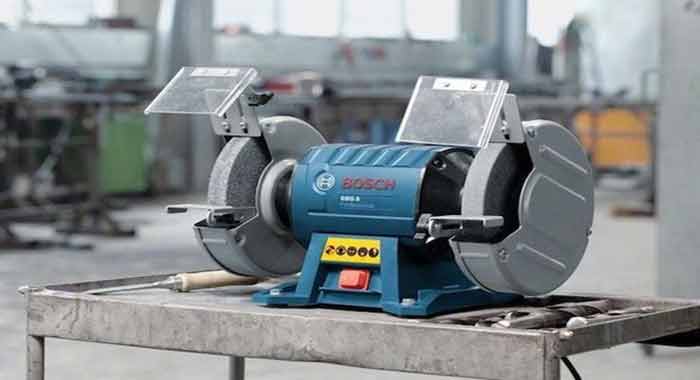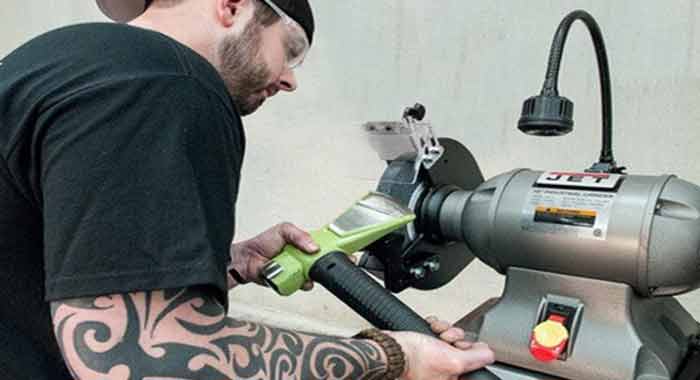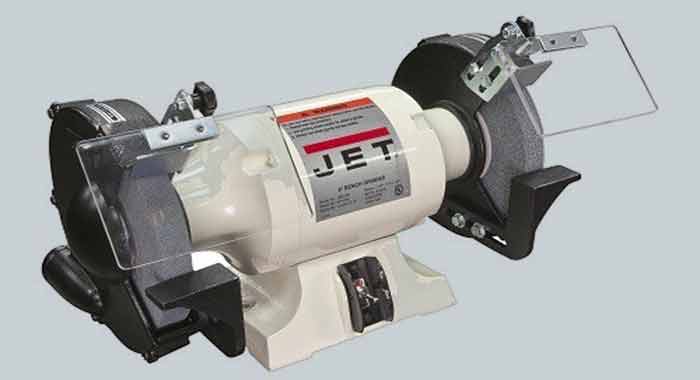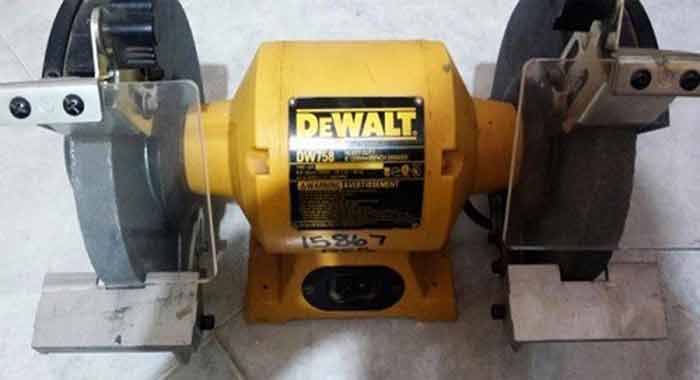Some tools tend to be underappreciated and overlooked in a woodworking shop. The bench grinder is often placed into this category. While you can use other tools to sharpen your blades and chisels, bench grinders are more reliable and have been used by professionals annually.
On this post, we’ll educate you everything you need to know about bench grinders. Investing in one helps you improve your workflow and complete your projects faster. Continue reading to learn how bench grinders work and why they are an asset to your metalworking needs.
Table of Contents
What Is A Bench Grinder?
Bench grinders are described as a tool used to shape, cut, and polish your metals. The grinders help the user by providing an excellent ergonomic grip when using it. Usually, you’ll see bench grinders located in workshops and metal working industries.
The more tools in your inventory, the more efficient and productive you’ll be. Having a bench grinder offers a lot of advantages. For instance, using a bench grinder reduces the need to spend extra money on tools that can be easily sharpened or repaired. Bench grinders are cost efficient, meaning that you’ll repair your tools at a fraction of the price.
Bench grinders consist of a two wheel system that:
Sharpen tools that became dull.
Fixing broken blades for riding lawn equipment and steel fans.
Fix and polish small steel pieces.
While bench grinders are effective, they are still a sensitive piece of equipment. The main body of the machine consists of two wheels. The wheels consist of pieces of stone with the addition of grit levels. The pieces of stone tend to act like smaller blades to help “chip” at the metal.
The reason why your bench grinder is useful is that of its rotation technique. Each grinder wheel comes with a rotating speed that’s designed by their manufacturer. When used with a proper wheel grit, bench grinders can repair/sharpen your tools.
Each of the bench grinder wheels moves at high speeds and is fragile. This means that you increase the chances of shattering or flattening the wheel. We suggest using small pieces of metal and wood to ensure that the wheel works without losing its quality.
All the parts of a bench grinder were designed to control the power and speed of your grinder wheels. While the main machine parts are straightforward, paying attention to each side reduces the risk of accidents and injuries.
Essential Bench Grinder Parts
Wheel Guards
Wheel guards are made to hold the wheel in place. When mounted correctly, it prevents the wheel from cracking or splintering. One reason why rotating wheels split is due to improper mounting. Your wheel guard prevents the wheel from breaking or rotating while in use. In fact, wheel guards save some damages and extend the lifespan of your bench grinder.
Tool Rest
The tool rest has a hard surface that’s outside the rotation area. Tool rests provide a consistent and smooth surface for the materials to be adjusted. Without a tool rest, shapes and cuts would become inaccurate or inconsistent. This issue results in wheel fragmentation or worse.
The main of using a bench grinder is its consistency and controllability. Changing the choppiness or consistency is dangerous to the bench grinder’s rotation speed. When added with the delicacy of coarse and fine wheels, tool rests are an important part.
Coarse Wheel
The coarse wheel is a round stone that grinds and rotates against the materials. The wheel is categorized based on the materials being altered, shaped, or cut. The coarse wheel provides the power and heavy lifting behind this mechanism. It gradually and continuously forms the materials placed on the bench grinder wheel.
Fine Wheel
The wheel of the grinder is used to polish and shine steel or other parts. When it’s replaced with a polishing brush, it gives a better appearance of the materials and improves its shine. This saves more money than hand-held sanders and requires the most care.
Eyeshield
An eye shield is the most important safety equipment to have while using a bench grinder. It’s found on the upper portion of the bench grinder. Get an eye shield to have better control over your device’s motor and increases the safety in your work place.
Spark Deflector
A spark deflector is a little piece that guards the lower and upper parts of the wheel. When it rotates, the piece prevents the sparks from getting into the user’s eyes and causing long-term damage.
Spark deflectors aren’t easily damaged unless the machine is misused. Without it, sparks would fly in all directions, causing a potential fire hazard, and reducing your performance throughout the project.
Best Bench Grinder Uses
Sharpening
The main thing you’ll use your bench grinder for is sharpening your metals. Doing this ensures that your metals come out in an even and well designed cut. Before sharpening, measure your materials to find a uniform size that you desire. This technique ensures that your metals will have perfect cuts while not losing any quality afterward.
Polishing
Bench grinders are useful in restoring the appearance of metal materials. For example, the brushes on the polishing keep the metal clean and remove certain ailments such as dirt, rust, from reentering the material. Get a polishing grinder if you need to restore the shine and value from our enemies.
Like buffing, polishing changes a metal material’s surface. But, the polishing process is used to prepare for the buffing process. Polishing involves improving the metal materials quality while removing oxidation. This is done by removing water spots, fading, cloudiness, and sun spots.
This doesn’t mean man that these results can’t be achieved by buffing. The two methods can be used interchangeably. But, they do have a few distinctive characteristics. For example, buffing is a coarser operation than polishing.
The best method to get a smooth surface for future projects is to remove and polish the chips, pits, swirl marks, and other defects first. In this method, polishing might require coarser substances to achieve the correct result.
Buffing
For most bench grinder owners, buffing is when a tool is used to shine and correct the surface of a metallic machine or device. The tool varies from orbital buffers or rotary buffers. A lot of higher end buffing tools have a voice operated assistant (Alexa) and orbital buffers to handle multiple functions.
Buffing works in conglomeration with a with a compound that’s supposed to smooth the surface of your metal materials. The materials are fine abrasives added to different types of greases to create solid stick or, fluid liquids.
There is a multitude of buffing methods available. For instance, cut buffing involves cutting and removing the surface of copper, brass, and other materials while coloring it as well. Cut buffing includes a bit of the rough buffing compound to create the user’s desired effect.
Types Of Bench Grinders
Electric Grinders
Electronic grinders have the function and appearance of a mini bench grinder. They are used for great tool usage projects and is easy to transport. Electric grinders are useful for workplaces that need quick tool repairs and metal adjustments on the go.
Automotive Grinder
Automotive grinders have more stability and durability than woodworking grinders. The grinders are reusable for extensive periods without needing to adjust the wheels. Automotive grinders are great for large scale projects where a large volume of metal is needed to be polished, buffed, or cut.
Variable Speed Bench Grinders
A variable speed grinder doesn’t work as it sounds. It offers different speed settings to give the use the ultimate flexibility and utility. This is important because the majority of speed benches don’t allow you to adjust the settings. With a myriad of settings, variable speed bench grinders make up for that problem.
Woodworking Bench Grinder
Woodworking requires a great deal of precision. Your tools have to be able to cut within a half centimeter. We suggest using a slow speed grinder for all of your woodworking needs.
Bench Grinder Accessories
In this section, we’ll talk about the different types of grinder wheels that are available. Each of the wheels is designed for a specific purpose and require some knowledge before using them. Continue reading to find out the best grinding wheels to help improve your effectiveness in your workspace.
Bench Grinder Wheels
Diamond Wheels
Diamond wheels are great for intensive projects where tough materials must be polished, cut, or buffed. They are grinding wheels that have industrial diamonds placed around the perimeter of the wheel.
You’ll want to use diamond wheels for cutting concrete, gemstones, and other sturdy materials. We suggest only advanced grinders use this wheel. Due to its materials, you don’t want to risk injuring yourself when using diamond wheels for your bench grinder.
Star Wheels
Star wheels are also called star dressers. The star wheels have a row of serrated, wavy, hardened, star-shaped cutters that are used to cut the metal at different angles. Force becomes applied to the part of the slowing wheel and is used to remove the abrasive grains in the wheel.
Safety Tips
Here is a quick table displaying the do’s and don’ts when using a bench grinder:
| Do’s | Don’ts |
| Wear protective gear such as safety goggles, protective gloves, and other essential gear during the bench grinding process. | Don’t directly touch a grinding wheel with any part of your body. You’ll expose yourself to injury and cause harm in the process. |
| Keep the wheel balanced with balancing weights. | Don’t overexert any force when pressing your workpiece up to your grinding wheel. |
| Check the maximum dimensions, operating speed, and other specs to make sure your machine works properly. | Don’t attempt to change the grinding wheels or start a test operation until you’ve received proper training on how to use a bench grinder. |
| Perform a test run each day you use the bench grinder. For newly mounted wheels, take at least 3 minutes to get used to it. | Don’t use the machine until the bench grinder cover is properly installed. |
| Take care of the wheels in a careful manner. Follow these three golden rules when storing the wheels “No dropping, no contact with other objects, and no rolling.” | Don’t exceed your bench grinder’s maximum speed. |
Manufacturers
WEN
For decades, WEN distributed created and manufactured affordable and high-quality power tools. Founded in 1951, the company created a name for itself by bringing electronics and tools together. If you’re looking for a high-quality tool for bench grinding, WEN is the superior choice.
Dewalt
Dewalt’s mission statement is to provide innovation that matters. This company has been around since the early 1920s. As the years progressed, they’ve created an excellent reputation by distributing high-quality tools, bench grinders, and electrical appliances at an affordable price.
SKIL
SKIL power tools is a leader in distributing portable power tools. The company began in 1924, and their target audience is the DIY consumer base and professional blue collar jobs such as construction. Buy a SKIL tool to enhance your effectiveness when cutting metals with your bench grinder.
JET
JET tools started in 1958. The company was intentionally made with the purpose of creating industrial air tools. As time progressed, they started to create bench grinders to be used for residential and professional use. This company is trustworthy and provides bench grinders that last year longer than the competition.
Maintenance And Cleaning
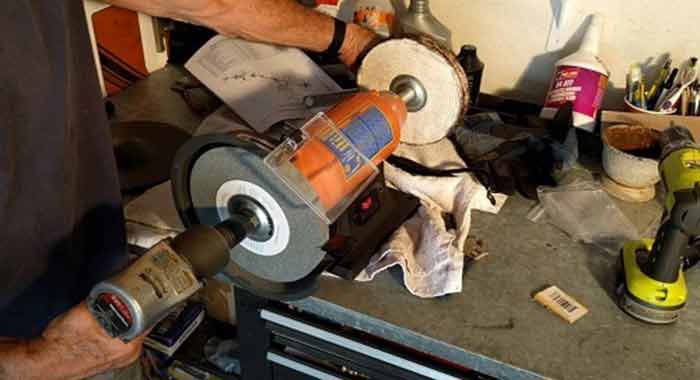
Removing Grinding Wheels
When the power is off, unscrew the shield that surrounds the grinding wheel. Find the center arbor nut and remove it and unscrew it with a wrench. Since your grinding wheel rotates in your direction, the right side wheel nut is threaded. This means that it unscrews by moving the nut in the front section of the grinder.
The left side nut, in some cases, unscrews by turning the wheel to the back of the grinder in the opposite direction. Once it’s unscrewed, take off the holding washer and the nut.
Attaching A Grinding Wheel
Place the grinding wheel hole on the axle shaft. Then, place the holding washer into place. Make sure to threat the nut right over the axle. Reverse thread the nut on the right side if possible. Keep the grinding wheel in your hand and tighten and hold the nut. Lastly, replace the shield, and you’ll have a new grinding wheel attachment!
Specs To Remember
In this section, we review a few specs that you should consider when getting your first bench grinder. Each grinder model has a different setting and is used for a specific purpose. Knowing the technical features helps you become a better buyer and make a better purchase decision.
Maximum Usage Speed & RPM
The speed your wheel rotates dictates the time needed to buff or sharpen a tool. Also, it dictates how fast the bench grinder heats up when it comes to contact with another metal. 3500 RPM is the average speed for a professional grade grinder.
The size and the safety of the wheel are the major determinants of the rotation speed. Big wheels don’t spin as fast because they are dangerous at high speeds. Letting a large wheel run at extreme speeds increases the chance of the wheel shattering. While it’s less dangerous to use a power grinder, it’s slower than your typical bench grinder.
You need to keep your grinder wheels as clean and fresh as possible. Once the pores used to operate the machine become clogged, the grinder becomes useless. Some users make the mistake of pressing harder on the grinder’s wheel. This is pointless and dangerous and can risk a serious thing to consider when you want a safe bench grinder machine.
The more press on your non-porous metals, the more heat that’s generated. As a result, the grinder overheats or the tool melts or being destroyed. Users run the risk of becoming injured or losing their life.
Match he optimal running speed to the model and material of your grinder. Doing this step ensures that the device continues to run without overheating and causing further problems later down the road.
Staying Balanced
The only form of dislodging danger a bench grinder offers is in its wheel setup. The coarse wheels become dislodged when not mounted correctly. This leads to the rotator of the machine becoming destroyed if not properly taken care of. Prevent dislodging by checking the washers once the wheel becomes set in place.
Your grinder wheel’s balance is similar to a car tire. If your tire isn’t balanced and rotated correctly, you run the risk of internally damaging the rotating mechanism. Grinder wheels work on that same principle. Another negative shift in balance occurs when the grinder wheel is fractured or broken.
That’s why it is important to inspect the quality of your grinding wheels before and after usage. To do this, make sure that both sides of the wheels are on the right track and positioned properly. After finding the proper spacing, tap the wheel to see its current operational status.
If you hear a bell like sound, that means your bench grinder is in good condition. On the other hand, you need to consider getting a replacement if there’s no sound. Chances are the device isn’t operating properly and needs some repair to keep it in a good working condition.
Dip Pan Vs. Rolling Pan
No matter what grinder you choose, cooling is an important factor. The way your grinder heats up is dependent on its size, type, and tool of the bench grinder. Some models have rolling pans that cool the metal and prevent overheating.
Other models have dipping pans that dip the metal inside of the pan to prevent temperature changes and to overheat. As the metals start to increase and decrease in heat, it wraps around the shape of the metal.
Dipping pans offer the advantage of molding and sharpening your metals in a short time span. This saves time from risking to overheat the metals or wait for the metals to cool down. If your metals heat up, they will fall apart faster and easier.
What’s Next?
Now that we’ve introduced you the world of bench grinders, there are a few things you’ll have to know. While simple, bench grinders come in different price ranges and can be confusing to pick one at first. We invite you to check out our buying guide for extra assistance.
In our buying guide, we’ll show five of the best bench grinders in today’s market. Each of the grinders is designed to help you get the most out of your projects. Take a look at the guide today to see which grinder is useful for your needs.

